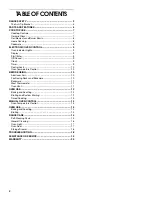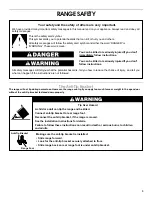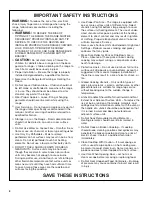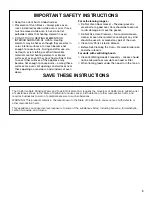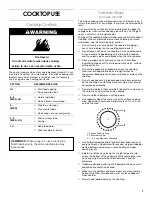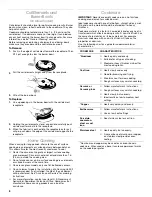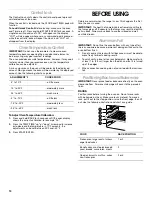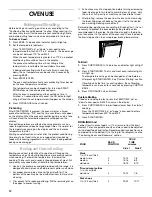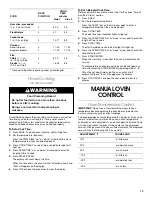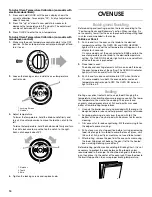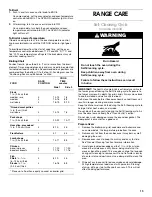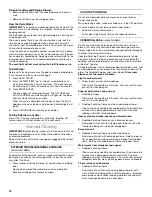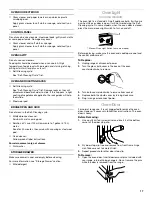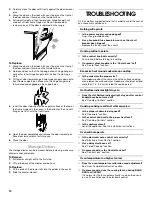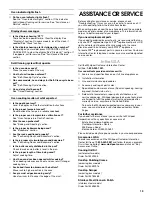
16
Prepare Cooktop and Storage Drawer:
■
Remove plastic items from the cooktop because they may
melt.
■
Remove all items from the storage drawer.
How the Cycle Works
IMPORTANT:
The heating and cooling of porcelain on steel in the
oven may result in discoloring, loss of gloss, hairline cracks and
popping sounds.
The Self-Cleaning cycle uses very high temperatures, burning soil
to a powdery ash.
The oven is preset for a 3
hour 30 minute clean cycle, but the
time can be changed. Suggested clean times are 2 hours 30
minutes for light soil and between 3
hours 30 minutes to 4 hours
30 minutes for average to heavy soil.
Once the oven has completely cooled, remove ash with a damp
cloth. Do not wipe down any of the inside surfaces until the oven
has completely cooled down. Applying a cool, damp cloth to the
inner door glass before it has cooled completely could result in
the glass breaking.
The oven light will not work during the Self-Cleaning cycle.
To Self-Clean:
Before self-cleaning, make sure the door is closed completely or
it will not lock and the cycle will not begin.
1.
Press AUTO CLEAN.
2.
Press the TEMP/TIME “up” or “down” arrow pad to set a
clean time other than 3
hour 30 minutes. The clean time can
be set between 2 hours 30 minutes
and
4 hours 30 minutes.
3.
Press START/ENTER.
The oven door will automatically lock. The ON, HEAT and
DOOR LOCKED oven indicator lights will light up. The door
will not unlock until the oven cools.
When the cycle is complete and the oven cools, “End” will
appear on the oven display and the oven indicator lights will
go off.
4.
Press OFF/CANCEL to clear the oven display.
To Stop Self-Clean any time:
Press OFF. If the oven temperature is too high, the door will
remain locked. It will not unlock until the oven cools.
General Cleaning
IMPORTANT:
Before cleaning, make sure all controls are off and
the oven and cooktop are cool. Always follow label instructions
on cleaning products.
Soap, water and a soft cloth or sponge are suggested first unless
otherwise noted.
EXTERIOR PORCELAIN ENAMEL SURFACES
(on some models)
Food spills containing acids, such as vinegar and tomato, should
be cleaned as soon as the entire appliance is cool. These spills
may affect the finish.
■
Glass cleaner, mild liquid cleaner or non-abrasive scrubbing
pad:
Gently clean around the model and serial number plate
because scrubbing may remove numbers.
COOKTOP CONTROLS
Do not use steel wool, abrasive cleansers or oven cleaner.
Do not soak knobs.
When replacing knobs, make sure knobs are in the OFF position.
On some models, do not remove seals under knobs.
■
Soap and water or dishwasher:
Pull knobs straight away from control panel to remove.
CERAMIC GLASS
(on some models)
Do not use steel wool, abrasive powder cleansers, chlorine
bleach, rust remover or ammonia because damage may occur.
Always wipe with a clean, wet cloth or sponge and dry thoroughly
to prevent streaking and staining.
Cooktop Polishing Creme is recommended regularly to help
prevent scratches, pitting and abrasions and to condition the
cooktop, and can be ordered as an accessory. See “Assistance
or Service” to order.
A Cooktop Scraper is also recommended for stubborn soils, and
can be ordered as an accessory. See “Assistance or Service” to
order. The Cooktop Scraper uses razor blades. Store razor
blades out of the reach of children.
Light to moderate soil
■
Paper towels or clean damp sponge:
Clean while the cooktop is still warm. You may want to wear
oven mitts while doing so.
Sugary spills (jellies, candy, syrup)
■
Cooktop Scraper:
Clean while the cooktop is still warm. You may want to wear
oven mitts while doing so.
■
Cooktop Polishing Creme and clean damp paper towel:
Clean as soon as cooktop has cooled down. Rub creme into
surface with a damp paper towel or soft cloth. Continue
rubbing until white film disappears.
Heavy soil, dark streaks, specks and discoloration
■
Cooktop Polishing Creme or non-abrasive cleanser:
Rub product into soil with a damp paper towel or soft cloth.
Continue rubbing until white film disappears.
Burned-on soil
■
Cooktop Polishing Creme and Cooktop Scraper:
Rub creme into soil with damp paper towel. Hold scraper as
flat as possible on surface and scrape. Repeat for stubborn
spots. Polish entire cooktop with creme and paper towel.
Metal marks from aluminum and copper
■
Cooktop Polishing Creme:
Clean as soon as cooktop has cooled down. Rub creme into
surface with a damp paper towel or soft cloth. Continue
rubbing until white film disappears. The marks will not totally
disappear but after many cleanings become less noticeable.
Tiny scratches and abrasions
■
Cooktop Polishing Creme:
Rub creme into surface with a damp paper towel or soft
cloth. Continue rubbing until white film disappears. Scratches
and abrasions do not affect cooking performance and after
many cleanings become less noticeable.

